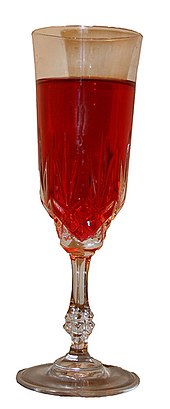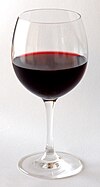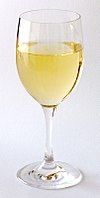Wine glass
This article needs additional citations for verification. (December 2011) |

A wine glass is a type of glass stemware that is used to drink and taste wine. It is generally composed of three parts: the bowl, stem, and foot. Selection of a particular wine glass for a wine style is important, as the glass shape can influence its perception.
Use
The traditionally held-to-be proper way to drink from a wine glass, especially when drinking white or otherwise chilled wine, is to grasp it by the stem.[citation needed] The most commonly accepted reasoning for this is to avoid fingerprints on the bowl, and to prevent the temperature of the wine from being affected by body heat.[citation needed]
Materials
High quality wine glasses are often made of lead crystal. Lead crystal glasses' advantages are not only primarily aesthetic. One factor of lead crystal is it is generally considered to have a higher index of refraction, thus changing the effect of light passing through them. Lead crystal is also rougher than glass on a microscopic level, allowing wine in the glass to breathe more efficiently when swirled in the bowl. They are also heavier. Using lead in the crystal matrix also offers several advantages in the material's workability during production. Wine glasses are generally not coloured or frosted as this would impede the appreciation of its colour. An exception to this rule is the hock glass.
Shapes

The effect of glass shape on the taste of wine has not been demonstrated by any scientific study and remains controversial. It is however believed by some that the shape of the glass is important, as it concentrates the flavour and aroma (or bouquet) to emphasize the varietal's characteristic. One common belief is that the shape of the glass directs the wine itself into the best area of the mouth from the varietal.[1] This is based on false ideas about the nature of taste buds on the tongue, such as the thoroughly debunked tongue map.
Generally, the opening of the glass is not wider than the widest part of the bowl.
Most wine glasses have stems, although "stemless" wine glasses are now available in a variety of sizes and shapes as well.[2] These glasses are typically used more casually than their traditional counterparts, as they negate the benefits of using stemmed wine glasses.
Most common wine glasses can be divided into three types: red wine glasses, white wine glasses and champagne flutes. Wine tumblers (without stems) are also increasing in popularity.
Red wine glasses

Glasses for red wine are characterized by their rounder, wider bowl, which increases the rate of oxidation. As oxygen from the air chemically interacts with the wine, flavour and aroma are subtly altered. This process of oxidation is generally more compatible with red wines, whose complex flavours are smoothed out after being exposed to air. Red wine glasses can have particular styles of their own, such as
- Bordeaux glass: tall with a broad bowl, and is designed for full bodied red wines like Cabernet Sauvignon and Syrah as it directs wine to the back of the mouth.
- Burgundy glass: broader than the Bordeaux glass, it has a bigger bowl to accumulate aromas of more delicate red wines such as Pinot Noir. This style of glass directs wine to the tip of the tongue.
White wine glasses

White wine glasses vary enormously in size and shape, from the delicately tapered Champagne flute, to the wide and shallow glasses used to drink Chardonnay. Different shaped glasses are used to accentuate the unique characteristics of different styles of wine. Wide mouthed glasses function similarly to red wine glasses discussed above, promoting rapid oxidisation which alters the flavour of the wine. [citation needed] White wines which are best served slightly oxidised are generally full flavoured wines, such as oaked chardonnay. For lighter, fresher styles of white wine, oxidisation is less desirable as it is seen to mask the delicate nuances of the wine. [citation needed] To preserve a crisp, clean flavour, many white wine glasses will have a smaller mouth, which reduces surface area and in turn, the rate of oxidisation. In the case of sparkling wine, such as Champagne or Asti, an even smaller mouth is used to keep the wine sparkling longer in the glass.
Champagne flutes
Champagne flutes are characterised by a long stem with a tall, narrow bowl on top. The shape is designed to keep sparkling wine desirable during its consumption. Just as with wine glasses, the flute is designed to be held by the stem to help prevent the heat from the hand from warming the liquid inside. The bowl itself is designed in a manner to help retain the signature carbonation in the beverage. This is achieved by reducing the surface area at the opening of the bowl. Additionally the flute design adds to the aesthetic appeal of champagne, allowing the bubbles to travel further due to the narrow design, giving a far more pleasant visual appeal.
Sherry glass

A sherry glass is drinkware generally used for serving aromatic alcoholic beverages, such as sherry, port, aperitifs, and liqueurs, and layered shooters. An ISO-standard sized sherry glass is 120 millilitres (4.2 imp fl oz; 4.1 US fl oz). The copita, with its aroma-enhancing narrow taper, is a type of sherry glass.
Boccalino

A Boccalino is a mug used by Swiss-German (locally known as Rösti, after the popular Swiss-German dish Rösti) tourists in Ticino, Switzerland, to drink local wine (Merlot or similar). It has a volume of 0.2 litres. The Boccalino is also a popular souvenir for the same Rösti.
Decoration
In the 18th Century, glass makers would draw spiral patterns in the stem as they made the glass. If they used air bubbles it was called an airtwist; if they used threads, either white or coloured, it would be called opaque twist.[3]
ISO Wine tasting glass
The International Standards Organization established a specification (ISO 3591:1977) for a series of glasses for wine tasting. They are stemmed with elongated tapered bowls, with capacities of 120 (for sherry), 210, 300, or 410 millilitres.[4][5]
Capacity Measure
As a supplemental unit of Apothecary measure, the wineglass (also known as wineglassful, pl. wineglassesful, or cyathus vinarius in pharmaceutical Latin) was, defined as 1⁄8 of a pint, or 2 fluid ounces (21⁄2 fluid ounces in the imperial system).[6][7] An older version (before c. 1800) was 11⁄2 fluid ounces.[8] These units bear little relation to the capacity of most contemporary wineglasses, or to the ancient Roman cyathus.
See also
References
- ^ "Shattered Myths". Gourmet. August 2004.
- ^ "Stemless Wine Glasses". Google search.[dubious ]
- ^ Clarke, Michael. (2001). The Concise Oxford Dictionary of Art Terms. Oxford University Press. [page needed]
- ^ "ISO 3591:1977". ISO.org. Retrieved 2012-02-09. (payment required)
- ^ "Wine glasses". Sizes.com. Retrieved 2012-02-09.
- ^ Edward Quin Thornton (1901). Dose-book and Manual of Prescription-writing. W.B. Saunders. p. 20. Retrieved 21 December 2011.
- ^ Weeks-Shaw, Clara S. (1808). A text-book of nursing: for the use of training schools, families, and private students. D. Appleton. p. 108. Retrieved 21 December 2011.
- ^ James, Robert (1747). Pharmacopoeia universalis: or, A new universal English dispensatory. Containing. An account of all the natural and artificial implements and instruments of pharmacy, together with the processes and operations, whereby changes are induced in natural bodies for medicinal purposes .. With a copious index to the whole. Printed for J. Hodges and J. Wood. p. 623. Retrieved 21 December 2011.
External links
- Scientific study on the shape of a wine glass and perception
- A general overview of Wine Glass Stemware This report examines wine glasses, discussing attributes relating to the flavour of wine.
